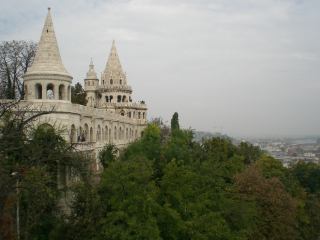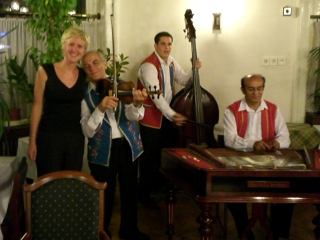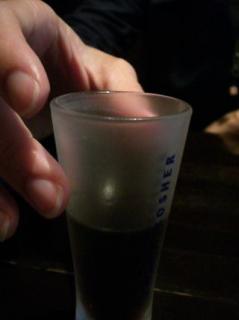Ahmedabad isn’t really renowned among tourists as anything special. As a hub in between Mumbai and Rajasthan, it serves the travelling crowd well with several hotels, but doesn’t offer a lot of excitement. It is chokingly polluted – so much so that at times it was difficult to breath for the exhaust fumes – noisy and bustling but we had read about a great restaurant serving Gujarati thali so we had to give it a try.
Thali wasn’t something I was really familiar with before we visited India as I hadn’t seen it on menus in Indian restaurants before, which is basically the limit of my knowledge of Indian food. We read that it is kind of an all-you-can-eat tray of various foods and sauces but that leaves a lot of room for interpretation. Also, the thalis vary according to region and we heard that Gujarati thalis were quite unique.
So, with anticipation of trying something new and delicious, we dressed up in our Indian finery (me in my new salwar kameez and Marc in his new polyester dress pants and sandals) and walked over to the House of MG Restaurant on the rooftop terrace of a heritage hotel.
In the lobby, we were presented with two set menus from which to choose: thali or deluxe thali. Each menu listed a string of dishes of which we had never heard so we just shrugged and selected ‘thali’. We were then led upstairs to the covered part of the terrace where the first course of veg pakoras and some kind of corn bread-y stuff was served with a coriander yogurt and a green, anise-flavoured juice. (We had stupidly forgotten the camera and were correct, it turns out, in thinking that we wouldn’t remember the names for any of the foods.)
Next, we were ushered onto the main dining terrace, lit with candles and decorated with small palms and ferns. At this point, we were given a menu of the meal which was about to be served (of little help to us stupid foreigners- for us, it read as “Eat the barblekurt with the skolwot”) and two small pages of instructions on how to eat thali. If not for that instruction sheet, we would have been entirely lost. As it was, we were pretty challenged by the whole affair. Unfortunately, it was a bit early so there were no other guests which meant that there was no-one else whom we could observe and copy.
First, they set a large stainless tray in front of each of us on which were placed four small stainless bowls. Each bowl contained a sauce/soup: yellow and savoury (dal?), white and sweetened, another savoury and something else with lentils. Then came two more serving dishes, one with a raw vegetable salad and one, a tray of condiments: spicy, jammy, raw onions, limes, and lime relish. With all this on our table, we had absolutely no idea where to begin; do we serve ourselves some salad? eat one of the soups, or are they actually sauces? select some of the garnishes for our plates? wait for more food? Oh yes, and there was a glass of salted buttermilk with floaties to drink.
The instructions, to which we referred for about the tenth time, said that thali is eaten with the hands, which we already knew, but that there are a number of rules to follow with regard to which hand is used for what. Right hand for eating, left for serving and drinking; but what about the soups? Do we dip stuff into the sauces with our fingers even though its hot? It was 80% mystery. Besides a couple of spoons for serving, we had no other utensils and, therefore, no choice but to just dive.
Eventually, we were served some chapatis which we knew we could tear into pieces and use to scoop up bites of food, and about four other servings of vegetables – bean salad, cauliflower stuff, eggplant stuff, something else… – and another couple of side-dishes/bowls with spiced yogurt and something else. It must seem obvious that we had virtually no idea what we were eating. But, fumbling though we were, it was all, without exception, very tasty thali and we ate until we were obscenely full.
The last challenge came in the form of paan. I’ve read about this in novels but could never discern what it was; it can be sweet, I knew, and could contain tobacco but that isn’t enough description to actually determine what paan is. Again, we had to pantomime our ignorance to one of the wait staff who demonstrated that the betel leaves wrapped into triangles around ‘something’ were meant to be eaten and swallowed as a kind of digestive. I took a big bite of one and learned that paan is filled with various spicy bits (anise and clove were the only two I could recognize) and menthol. I must have chewed for ten minutes before being able to swallow. That was my first, and will be my last, experience with paan.
At least we have pictures of a couple of things we ordered when we returned to the informal, ground-floor garden part of the restaurant. Never a disappointing dish.
 This morning, we treated ourselves to a morning walk to the Starbucks on Istiklal street. There are 36 Starbucks in Istanbul and so far, we have seen only his one. It’s in a trendy area and it seems to be full of business people and private school teens.
This morning, we treated ourselves to a morning walk to the Starbucks on Istiklal street. There are 36 Starbucks in Istanbul and so far, we have seen only his one. It’s in a trendy area and it seems to be full of business people and private school teens. We don’t go for Starbucks very often here because of the option of going for tea. Served scalding hot, with two lumps of sugar in a small glass, our tea breaks have been something I look forward to each day. In our favourite tea shop, a short walk up the hill, there are boardgames and backgammon boards for people to use while sipping and puffing on hookahs. It’s cozy inside, with lounging cushions and pillows on the floor in a couple of rooms, and booths and easy chairs in the front and back. Such an enjoyable ritual to adopt.
We don’t go for Starbucks very often here because of the option of going for tea. Served scalding hot, with two lumps of sugar in a small glass, our tea breaks have been something I look forward to each day. In our favourite tea shop, a short walk up the hill, there are boardgames and backgammon boards for people to use while sipping and puffing on hookahs. It’s cozy inside, with lounging cushions and pillows on the floor in a couple of rooms, and booths and easy chairs in the front and back. Such an enjoyable ritual to adopt. We have been making gluttons of ourselves with the Hungarian repasts. On the night of our arrival, the fellow working the reception desk at our pension recommended a place that makes good Hungarian food for a reasonable price and is within walking distance: the only three criteria we had for our supper. (Actually, we would’ve broken down and eaten almost anything at that point – even KFC! – as we were starving and tired and much too sober.)
We have been making gluttons of ourselves with the Hungarian repasts. On the night of our arrival, the fellow working the reception desk at our pension recommended a place that makes good Hungarian food for a reasonable price and is within walking distance: the only three criteria we had for our supper. (Actually, we would’ve broken down and eaten almost anything at that point – even KFC! – as we were starving and tired and much too sober.)
 The following morning, we headed straight for a coffee house recommended by our guidebook as “a classic”. Apparently, idealist types in the nineteenth century used to meet to discuss politics in the coffee houses of Budapest and, often, a revolutionary movement would be named after the coffee house in which the principle discussions were held. We went to Gerbaud’s to have sachertorte, fruit torte and bitter, little coffees. (I don’t know of any ‘Gerbaud’ movement…)
The following morning, we headed straight for a coffee house recommended by our guidebook as “a classic”. Apparently, idealist types in the nineteenth century used to meet to discuss politics in the coffee houses of Budapest and, often, a revolutionary movement would be named after the coffee house in which the principle discussions were held. We went to Gerbaud’s to have sachertorte, fruit torte and bitter, little coffees. (I don’t know of any ‘Gerbaud’ movement…) Shortly thereafter, we met with The Largest Meals We Have Ever Been Served at a pub on the Pest side of the Danube that we entered just moments before it started pouring rain. Because pub food tastes better when it is cold outside, we each ordered a heavy meal: smoked-meat-stuffed schnitzel for me; liver-stuffed schnitzel for Marc. Add a couple pounds of potatoes and a half kilo of rice to the table, plus two cups of cabbage salad and a liter of beer, and we have our lunch.
Shortly thereafter, we met with The Largest Meals We Have Ever Been Served at a pub on the Pest side of the Danube that we entered just moments before it started pouring rain. Because pub food tastes better when it is cold outside, we each ordered a heavy meal: smoked-meat-stuffed schnitzel for me; liver-stuffed schnitzel for Marc. Add a couple pounds of potatoes and a half kilo of rice to the table, plus two cups of cabbage salad and a liter of beer, and we have our lunch.